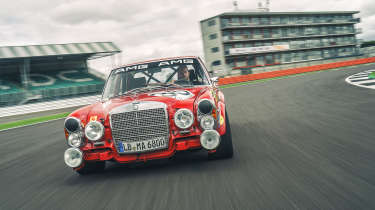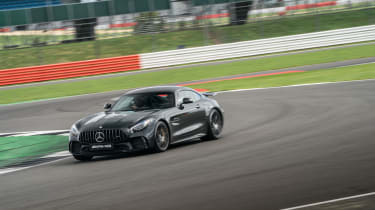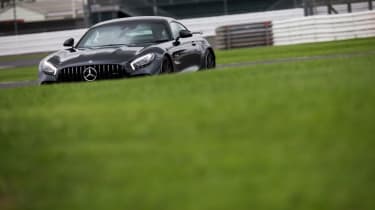50 years of AMG – history and best cars of the Mercedes tuner and race team - Mercedes-AMG GT R
We drive four of AMG’s most significant cars to chart the history of the marque
Mercedes-AMG GT R
In 2010 Mercedes released the SLS, the first car that AMG had designed, developed and built from scratch. A departure from the small saloons, big coupes and luxurious drop tops, the SLS was proper aluminium bodied sports car. It was also fitted with a tweaked version of AMG’s then legendary 6.2-litre naturally aspirated M156 V8 engine. The SLS also gave AMG the opportunity to enter another form of motorsport, GT3 racing.
As AMG, and the rest of the world, moved towards downsized turbocharged engines the SLS, and its massive engine, needed to be replaced. Its successor was the AMG GT – smaller, nimbler, faster and more powerful thanks to the firm’s new hot-V twin-turbocharged 4-litre V8. There have been many iterations of the GT so far, despite being only three years old: the standard car with no suffix letter, the S, the C and the R.
With 577bhp (121bhp more than the standard car), a wider body, Cup 2 tyres, a focussed chassis and 10 stage adjustable traction control, the GT R is, currently, the ultimate AMG.
Just like all of the GTs the R takes a little getting used to. The immediate impression is that there’s something strange about the relationship between where you’re physically sat within the car’s footprint – towards the rear, almost over the rear axle – and the fast, alert steering. Being so far away from the front axle, but having the ability to influence the front wheels with such small movements doesn’t feel natural, like trying to perform key-hole surgery with metre long implements.
But, you can’t fault the grip and agility that the front end endows the GT R; it turns sharply thanks to minimal roll and masses of traction. It gives you all the attributes to help you get used to the distance you’re sat from the front wheels.
> Read our full review of the Mercedes-AMG GT R
Stiff and uncompromising on the road – although to give it its dues, not actually too harsh – it’s clear the GT R is suited to the track. Out on a circuit you can apply proper force to the chassis, allowing it to lean on the outside tyres, the body rolling just enough to give you an idea of how much grip is available. And it turns out there’s lots of lateral traction, and once loaded up, it hangs on admirably.
It’s such a frequently used statement that it’s become a motoring journalist’s cliché, but the GT R’s 4-litre V8 isn’t as characterful, or as sonorous, it’s delivery isn’t as linear, nor is it as addictive to use as the older naturally aspirated engine found in the SLS. The new motor is potent, yes, but you’d happily trade that extra straight-line speed for the noise alone.
However, the huge amount of low down torque the turbocharged engine does provide means you could, if given the freedom, play the hooligan burning up the rear tyres wherever it takes your fancy. To keep everything in line requires smooth movements and self restraint. Despite the eager engine and fast steering, it is possible to pedal the GT R in a calm, controlled but fast manner without too much practice.
Just as the SLS did, the GT provides AMG the platform to compete in GT racing. As well as a GT3 version of the car, which incidentally still uses the SLS naturally aspirated engine, there’s AMG new GT4 car now too. Despite AMG having pulled out of touring car racing, the firm is staying dedicated to its roots competing in endurance racing.










